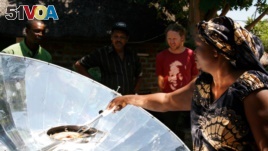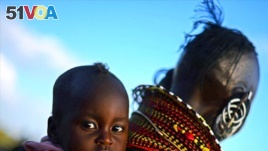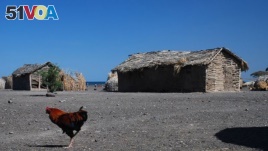August 24, 2012
A few years ago, a Dutchman with a dream walked into a government office in Nairobi. In his hand he carried an application form to lease land near Lake Turkana in Kenya’s isolated north-east.

Wind turbines similar to these in California's Yucca Valley region are soon going to be part of Africa's largest wind farm, in northern Kenya [Photo: AP]
The entrepreneur, who has lived in Kenya for the past 23 years, told the government official, “We are going to build a power plant to make electricity with the wind.”
Van Wageningen said the commissioner had stared at him as if he were crazy. “Then he said, ‘How much of this land do you want to lease?’ And I said, ‘A hundred and fifty thousand acres.’ And to that he replied, ‘Would you like 300 [thousand acres]?’”
The businessman said the story indicated the perceived “worthlessness” in Kenya of the country’s arid north, a harsh desert where temperatures often top 100 degrees F [40 degrees C]. The region is home to little more than scorpions, a few nomadic groups and their cattle and camels.
But it’s also the scene of a phenomenon that’s unsurpassed elsewhere in the world – a natural wonder that’s set to drive the biggest renewable energy project yet seen in Africa.
Fishing trips spark massive power project
Van Wageningen is the chairman of Lake Turkana Wind Power [LTWP], a consortium of several international firms, including Dutch company KP&P Africa B.V., Aldwych International and the Industrial Development Corporation of South Africa.

The site where the Lake Turkana Wind Power project is to be built [Photo: LTWP]
Backed by the World Bank and the African Development Bank, at a cost of almost $720 million dollars it will be the largest single private investment in Kenya’s history.
The plan’s roots lie in several fishing trips to Lake Turkana in the late 1980s by one of van Wageningen’s business partners, Willem Dolleman. “On those expeditions he was troubled by strong winds that never seemed to stop. He used to come back and tell me, ‘We’ve got to figure out a way to use all that wasted wind energy….’” van Wageningen remembered.

The wind farm is to be established near Lake Turkana, the biggest desert lake in the world and the scene of extremely strong and regular winds [photo: AFP]
Unique wind
In 2005, van Wageningen and Dolleman invited a skeptical wind power expert from The Netherlands to visit their proposed project site.
“He instantly fell in love with it – not only because the wind was constantly blowing, but (also) because the area was deserted,” said van Wageningen. “There’s no population so you don’t disturb anybody, and there’s no wildlife, or very little of it. He said, ‘This is really a perfect site. This is actually a wind power developer’s dream.’”

The project is expected to bring electricity to millions of Kenyans who've never experienced the benefits of power [photo: AP]
“This is probably…the best wind [energy] site in the world. The wind is consistent; we have no sudden gushes [sic] of wind, it is really very regular; it is very predictable at various times of the day,” said van Wageningen.
Very much wanted
The wind power plan is supported by the government of Kenya – with good reason. Using 365 power units, each with a capacity of 850 Kilowatts [Kw], the exceptional wind will allow the project to produce electricity at a rate that’s unprecedented in the field of wind energy.
“We can produce, with the same installations, about double the power that is normally produced from wind power in Europe. That means that the cost of that power drops considerably and that is why we can become a competitive source of power without [government] subsidies. We will be the cheapest source of power after geothermal, by a very small margin,” said van Wageningen.

The massive clean power project will be driven by a wind phenomenon called the Turkana Jet Stream, which results in wind diverting off Mount Kulal, which can be seen on the horizon in this photograph [Photo: LTWP]
He predicted that the plan will save Kenya almost $150 million that it currently spends on importing fuel to generate electricity every year. LTWP will also pay about $28 million a year in taxes to the state.
Van Wageningen laughed, “Let’s just say that for Kenya and its economy, this is a project that is very much wanted.”
Jobs boost
The LTWP chairman added that it will create 2,500 jobs during the three-year construction phase, which is scheduled to begin once various funding processes have been completed. This is expected to happen within the next few months.
Van Wageningen said almost all of the work will be given to people living in north-eastern Kenya. In addition, hundreds of permanent jobs will be available once the project is operational.
But before the energy plant can be built, LTWP must build and upgrade roads in northern Kenya.

The massive clean power project will be driven by a wind phenomenon called the Turkana Jet Stream, which results in wind diverting off Mount Kulal, which can be seen on the horizon in this photograph [Photo: LTWP]
His consortium must also build 100 kilometres of on-site roads, to facilitate project construction, operations and maintenance. “The road building and associated transport needs will create many more jobs, primarily for local Kenyans,” said van Wageningen.
Business explosion
The LTWP project, because it will generate clean power and won’t pollute the atmosphere, will earn about one million “carbon credits” annually from the United Nations. At today’s carbon credit prices, that would represent $8.6 million a year.
“We are returning that to the government entirely,” said van Wageningen. “And the government has accepted to devote 100 per cent of that income to the development of the communities in and around our [site] area and along the [electricity] transmission line route. That is a lot of money for an area that has hardly seen any investment at all.”

One of LTWP's wind data masts measures wind at the site near Lake Turkana [Photo: LTWP]
He added that LTWP will establish fisheries at Lake Turkana, and clean water projects that could end conflicts between various ethnic groups who have for centuries fought for control of scarce water points.
Ghost of corruption
With so much money in play around Africa’s greatest-ever clean power project, and with Kenya’s reputation as one of the most corrupt places on earth, van Wageningen acknowledged that all over the world he has been asked, “‘Did you have to pay a huge bribe to win government support for your project?’”
His answer to the same question from VOA was an emphatic, “No, no, no.”

The consortium says local Kenyans, such as some members of the Turkana ethnic group, will benefit from the construction of the wind farm [credit: AFP]
Explaining why no one had ever tried to extort a bribe from LTWP, van Wageningen said, “The reason why I truly believe that we have never received any approach is very likely due to the fact that we are located on the moon. Most Kenyans – I would say up to 80 per cent of Kenyans – don’t even know that [the north-eastern desert] is part of Kenya!”
In addition, he said corruption syndicates had ignored the project because when it was being planned “almost everyone” was ignorant of the potential for wind energy in Kenya’s most remote region and were convinced that it would fail.

The wind farm will bring electricity to villages, such as this one in Loiyangalani district, fostering much-needed development [Photo: LTWP]
By the time that people realized it would work and grasped the kind of money involved, said Van Wageningen, it was “simply too late” for corrupt individuals to “demand a slice of the cake,” because he and his partners had already secured the support of the African Development Bank.
“The level of scrutiny that such an entity subjects a project of this size to and the behavior and ethics that it demands made us immune to unethical approaches,” said van Wageningen.